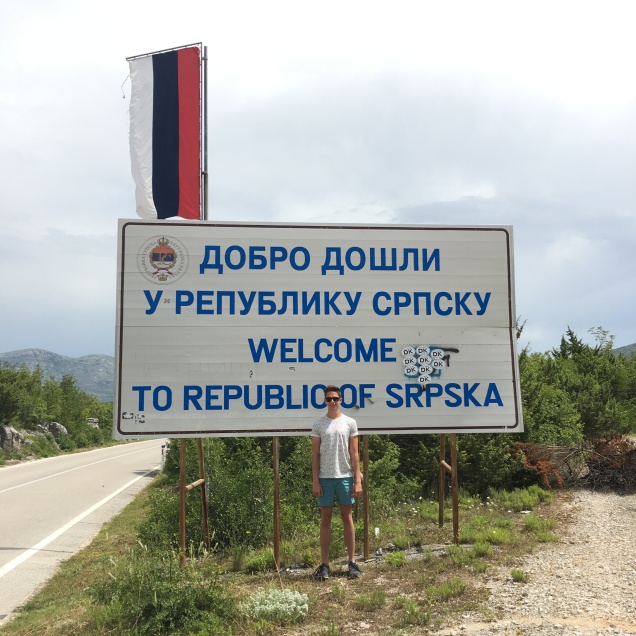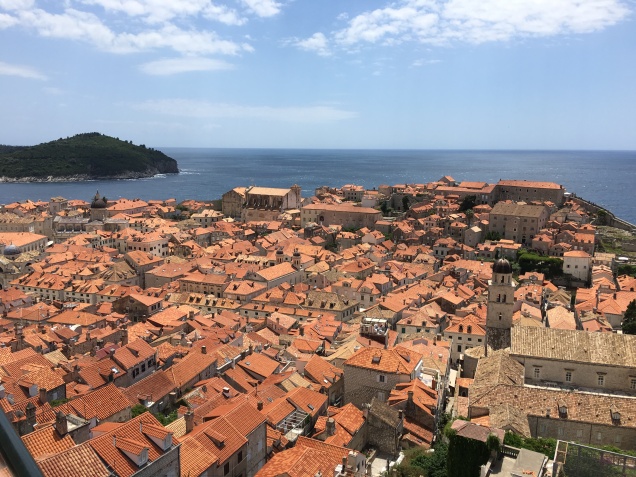Dubrovnik is hardcore, unadulterated sightseeing. This is the kind of place you can go on a two-day walking tour of, and still only have seen the main streets. The Old Town (Stari Grad) is a UNESCO World Heritage Site for culture, as well as being one of the most visited places in the Mediterranean and as a setting for Game of Thrones. Its position in Europe also makes it easily accessible from Central Europe, and Croatia’s position in the European Union has given people easy access to visit. Walking down toward the Old Town it is clear to see why this walled city has become so popular.
My initial thought walking down to the gate of the old town was mostly just shock about the number of people around. Having come from uncrowded Albania that afternoon, to be surrounded by hoards of tourists and tour guides and people selling canoeing tours and people selling segway tours and people selling Game of Thrones tours and people selling island hopping boat tours (you get my point) was overwhelming. We also had to get used to the idea of tourist economic exploitation once more – a two-scoop ice cream cone each in Macedonia or Albania would be less than £1, and a couple of rounds of beers in a bar would never come to more than £5. Suddenly we were surrounded by the opportunity to spend big, and it takes some getting used to not being able to buy anything without worrying about being ripped off by inflated prices. What was also a shock was the sheer amount of souvenir shops, cafes, bars, restaurants etc along the main street in the old town. We ended up walking round for a couple of hours, shellshocked from spending 6 hours in the car, then finding somewhere for dinner.
The next day we walked back down toward the old town, and decided to do the famous ramparts walk – a 2km route around the top of the city walls, offering the best views of all the main sights and of the entire city. To date on our trip, entrance fees for museums and sights had been pointlessly negligible. The city walls however, were 120 Croatian Kuna each (slightly more than £12) – which explains why the Dubrovnik local government has so much money to spend on renovation and upkeep of the city. The walk was worth the price though; you are funnelled anticlockwise around the wall and there is loads to see – and I am told by my Game of Thrones fanatic boyfriend that it was interesting from that perspective too. I found it interesting to see the rebuild of Dubrovnik after the 1995 siege (the differences in the colour of roofs being the easiest way to see which houses were bombed/burned and which survived intact).
The main street in Stari Grad Dubrovnik, and the view of the old town from the highest part of the walls
After lunch we explored more sights in Dubrovnik – the harbour, the key religious buildings and the views out to the sea. that evening we got in the car and went out to explore the rest of the area around Dubrovnik – some beautiful views of the mountains and much quieter than the main old town.
The view of the city walls in Dubrovnik, and the view from the other end of Dubrovnik
Overall I had found Dubrovnik to be beautiful and fascinating, breathtakingly clean and well maintained, but expensive and rather crowded. Every establishment is organised in such a way to make as much money as possible from tour groups, and I missed the peaceful emptiness of Ohrid, or the everyday life of Albania. The cost of rental accommodation in Dubrovnik stopped us staying much longer (we paid over £65 a night for a tiny tiny apartment), and the cost of food and drink made eating out a bit unnecessary.
The following morning we packed up again, and drove away from Dubrovnik to the border with Bosnia & Herzegovina. As we only visited for half a day, it is easier to write about Bosnia at the end of this blog rather than attempt to fill another. The border between Croatia and Bosnia & Herzegovina is surprisingly close to Dubrovnik (25 mins) and surprisingly rural (the border post was just a gate across a road, rather than a commercial, logistical centre like other we’d seen). Before long we had yet more passport stamps, and had welcomed in our 5th country.
Of all the constituent countries of Yugoslavia, Bosnia & Herzegovina probably has the most interesting, diverse and varied history. A key battleground between Christians and Muslims, Bosniaks and Serbians and Serbians and Croats, Bosnia is today the rural, undeveloped cousin of its former Yugoslav neighbours, Croatia and Slovenia. Bosnia also has a slightly weird political geography – being effectively split into two countries; the Federation of Bosnia & Herzegovina in the centre, west and south-west of the country, and the lesser known Republika Srpska in the north-east, east and south of the country. The former, Bosnia & Herzegovina (usually BiH) contains the largely Bosnian Muslim (Bosniak) population, whilst the latter, Republika Srpska (RS) contains the Serbian population (and, arguably, the most trigger happy of all Bosnia’s people). The two states are largely autonomous of each other, and have their own rules and regulations. We had entered into BiH, but on the drive to the town of Trebinje, entered into RS.
 My excitement at entering into a largely unknown territory
My excitement at entering into a largely unknown territory
I absolutely loved the parts of Bosnia we visited – the town of Trebinje is absolutely beautiful, and the unstable nature of the Bosnian Convertible Mark meant that everything was dirt cheap – a round of coffees for 80p and lunch menus never offering meals costing more than £3 or £4 (even petrol is about 60% of the price of neighbouring Croatia or Montenegro). I haven’t really spoken about the food in the Balkans yet as it is all generally unsurprising – but one thing common in the region is to order a’hamburger’ (or mistranslated as hamburg) – basically just the burger patty containing cheese/ham/mushrooms and served without a bun, with chips and salad.
 The view of Tribinje from the river crossing
The view of Tribinje from the river crossing
After lunch we walked around in the sweltering heat, then got back in the car and headed toward the Montenegrin border an hour away. This drive was spectacularly scenic – mountainous and rural – and absolutely deserted. We had only witnessed Montenegro from the main road in the most populated area so far, so it was interesting to see the more rural areas of the north-east as a contrast to the busy hypermarkets and strip malls of Bar and Budva’s ring roads.
 Welcome to Crna Gora sign, high in the mountains.
Welcome to Crna Gora sign, high in the mountains.
We entered Montenegro again, and for the first 50km the drive was pretty unremarkable. As Montenegro has NO motorways (not even a dual carriageway) progress is always pretty slow – and catching up a slow lorry is followed by some precarious overtaking (especially if your hire car is a 1 litre Skoda hatchback). After a while we rounded a corner and saw a huge queue of traffic, and came to a stop. In the UK this could be for a number of reasons – traffic lights, roadworks, a traffic collision etc – but in Montenegro it turned out to be a delay due to boulders across the road. This is somewhat difficult to explain (and I don’t really understand myself) but as far as I understand, roads in Montenegro are liable to be closed, at short notice, without warning, for roadworks and building. The way the road is closed is that some kind of blockade is put across the road – both lanes – and one unfortunate individual has the unlucky job of standing by the barrier and breaking the news to motorists that the road is closed for the next couple of hours. In the UK this would be an inconvenience – but even where I live in semi-rural Gloucestershire there is always an alternative route. In the mountains of Montenegro however, there is only one road, with the only alternative being to drive all the way back to Bosnia and round. We walked to the front of the queue of traffic – some 100 cars, lorries and coaches – by which point men were making efforts to move the boulders and open the road, which they managed. All in all a very peculiar experience, and after a delay we were back on the road and headed for Podgorica.
 Moving the boulders – a traffic jam in rural Montenegro
Moving the boulders – a traffic jam in rural Montenegro



